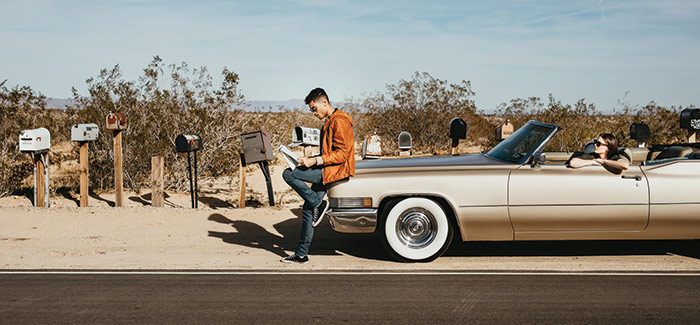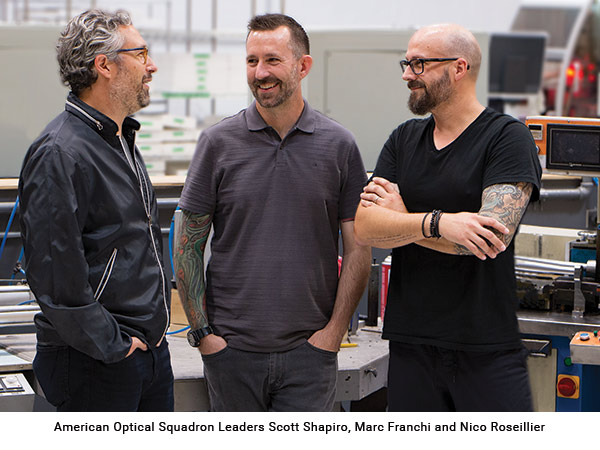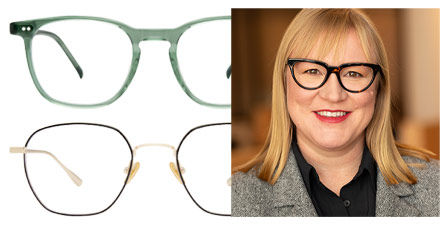
Photographs by Marissa Roseillier
As a follow through to the in-depth American Optical cover feature in our 20/20 September 15 What’s Brand New issue, here is the inside story on what it takes to deliver such a unique heritage brand that’s Made in America. Direct perspectives from both a design and manufacturing POV as delivered by creative director Nico Roseillier and Marc Franchi, president of Independent Eyewear Manufacturing (IEM) in Chicago where all of the AO and State Optical eyewear are made.
–James J. Spina

NAME: Nico Roseillier
TITLE: Creative Director
GIG: Designing stuff
20/20: Give your impressions of AO from before you ever heard that State/Europa would be acquiring the brand.
NICO ROSEILLIER: I knew the brand from back in my days in NYC when I used to go to Fabulous Fanny’s to do research. At that time, they carried vintage frames.
Although I didn’t know that much about the brand, I knew the famous moments, like when Neil Armstrong landed on the moon with an AO frame, and how JFK’s favorite sunglasses were the AO Saratoga. I had no idea about the extent of the brand and all the contributions it made to the eyewear and lens world for almost 200 years.
Give your impression of what you thought when you heard AO was becoming part of State/Europa and that you would be designing AO eyewear.
Scott told me about the idea of acquiring American Optical a few weeks after I started at State. But for the longest time we used to joke that I didn’t want to know any updates until it was a done deal, as I knew I would be designing the frame in my head already.
Describe your AO design process and include how it differed from what you did/do with State/Europa.
I have been spending a lot of time doing research. For me, I couldn’t start designing for an iconic brand without doing my due diligence and educating myself on every aspect of that brand. For AO, it wasn’t just the frames, but all the history since 1833, from the architecture of their campus to the packaging. I had enormous help from Dick Whitney and Diane Mattuck at the Optical Heritage Museum in Southbridge, Mass., and was able to do a very deep dive in their archives and find out a lot of knowledge about the brand. AO at its peak was more than just an eyewear company. It was the heart of that town and a huge part of the community.
Designing American Optical products is, in a sense, very similar to the redesign of the Ford Branco or the Land Rover Defender; taking classic and iconic design to the next chapter of the brand. This is a big challenge.
Where do you see AO going within its first debut year? Where do you see it in the next five years?
On the design side, I see it as building the brand back in a very respectful way. We are definitely looking to the past to bring the future chapter of the brand. Some models will be inspired by vintage AO styles, and some will take on new designs. Some of the styles we’re launching this year are based on AO designs from 1935 to the 1960s. They are actually perfect for today’s fashion, with just a little tweaking.
Tell the story of your past in optical—companies where you worked, eyewear and brands you designed.
I will try to make a long story short. I landed in the U.S. from France a little over 20 years ago, with a background in microengineering. After studying architecture and industrial design, I had my own company for five years working for some different eyewear companies. Then I became creative director at Modo for five years and then Rem for 10 years. I have designed for some amazing brands through the years including Derek Lam, Phillip Lim, Tumi, Converse and John Varvatos.
Eyewear isn’t just about product. What other aspects of AO have you been designing and working on?
As a creative director, my role isn’t just about the design of the frame, though that is very important. I try to look at the brand holistically. So far, for AO I have designed the cases, packaging, cleaning cloths, presentation box, merchandising and many other aspects devoted to the brand. Our amazing marketing team and I have worked on every aspect of the brand relaunch.
We also worked with my very talented wife Marissa who photographed the new advertising campaign for the relaunch of the brand.The potential for this brand is very exciting, and I look forward to stretching my creative process in order to make American Optical everything I know it can be.

NAME: Marc Franchi
TITLE: President, Independent Eyewear Manufacturing (IEM)
GIG: Making frames & reverse engineering… everything
MARC FRANCHI: The scene around the factory resembles a beehive. There is a ton of activity, with dozens of craftspeople focused on their individual tasks, wearing masks 6 feet apart, of course. At any given time, multiple brands or productions can be running in parallel, pulling individual craftsmen in different directions; but all with the common goal of delivering the highest quality American made product possible.
Everyone in our production facility has an incredible amount of pride in the work they do, but that feeling has been amplified with the addition of American Optical. They know how important it is to get this product right.
What were new challenges for AO that had to be attended to in order to create AO? Detail the process of making metal frames that had to be considered with this new venture.
The manufacturing of AO created some unique challenges for us, the first being setting up a new production within our existing facility. There is almost no overlap between acetate production and metal. So not only did we have to bring in, set up and learn all new equipment and production techniques, we also had to develop the supporting infrastructure. This means workflow process, paperwork, procedures and training—a lot of training—for an entirely new production. Once the nuts and bolts of the process were nailed down, we were then able to focus on fine tuning the product.
Compare or address the current product to what was being delivered just before State/Europa bought the brand.
We determined from the onset that we wanted to keep AO’s iconic styles true to their original design and specs while improving the product with 21st century manufacturing techniques and components. For example, to craft the Original Pilot—one of AO’s most iconic styles—we created all new tooling and fixturing in house to match the design and military specifications the product was originally produced with. We then used the latest technology in soldering equipment to ensure the best possible solder joints, coupled with the highest quality materials and components available, to make a product superior to anything that came before it. We will continue to develop and improve techniques to ensure that AO’s product is always of the highest quality.
From a manufacturing POV and from the perspective of being made in America, define what the brand means to you.
I think most people can agree it is important to make products here in the U.S. We take a lot of pride in the fact that we are one of the few to make eyewear here; so when we had the opportunity to bring American Optical’s eyewear production to our facility, we were humbled. To be able to continue the manufacturing heritage of the true original American made eyewear brand is a real honor for us. We are very excited about bringing AO to the next generation.
Briefly review your optical history pre-State.
My optical career began in 2009 when my cousin, Jason Stanley and I purchased an unknown and struggling eyewear brand, friezeframes. At our very first Vision Expo, we realized how few eyewear brands were produced in the U.S. and set out to build our own factory. We opened our first factory in Ventura, Calif., in January 2012, where we produced our own brands as well as some private label product. In 2014 we partnered with Europa Eyewear and came to Chicago to build the state-of-the-art facility that produces the brands State Optical, Alan J and now American Optical. ■












